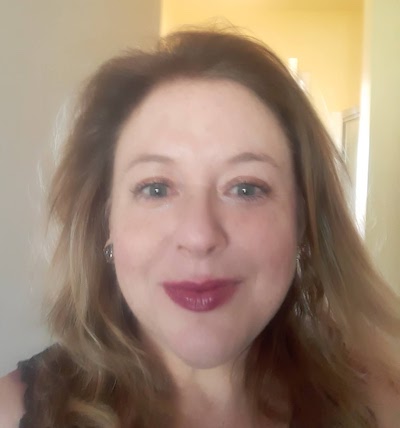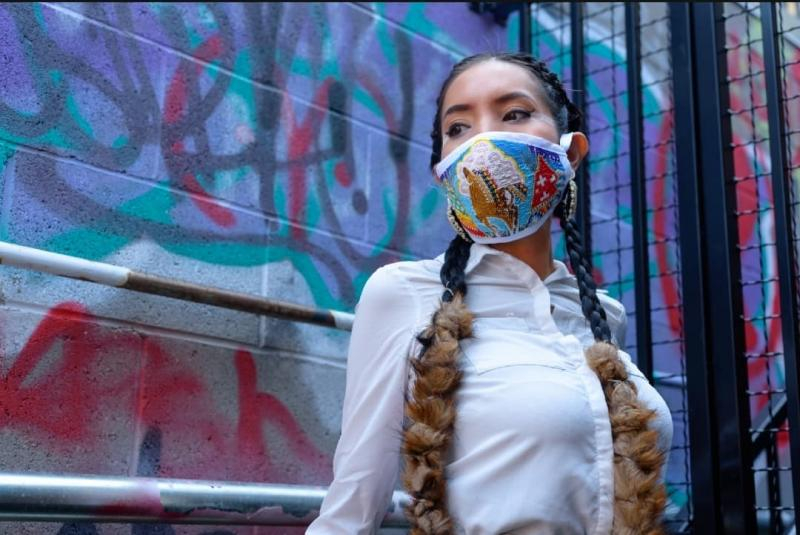
- Details
- By Tamara Ikenberg
At the height of Delaena Rae Uses Knife’s battle with COVID-19, the Lakota artist spent three restless days in a Rapid City, S.D. apartment with a fever of 103 degrees Fahrenheit, chills, body aches and headaches, rash, and congestion.
“It was a scary moment because my parents were stuck on the reservation,” said Uses Knife, who is Lakota Mnicoujou from the Cheyenne River Sioux Tribe. “My family couldn’t be with me or around me and I was afraid to sleep at night because I’d heard stories of COVID-19 patients unable to breathe at night.”
It took three weeks to vanquish the virus. When Uses Knife’s strength returned, she commemorated her triumph by beading a face mask awash with Lakota geometric designs and symbols of war and peace.
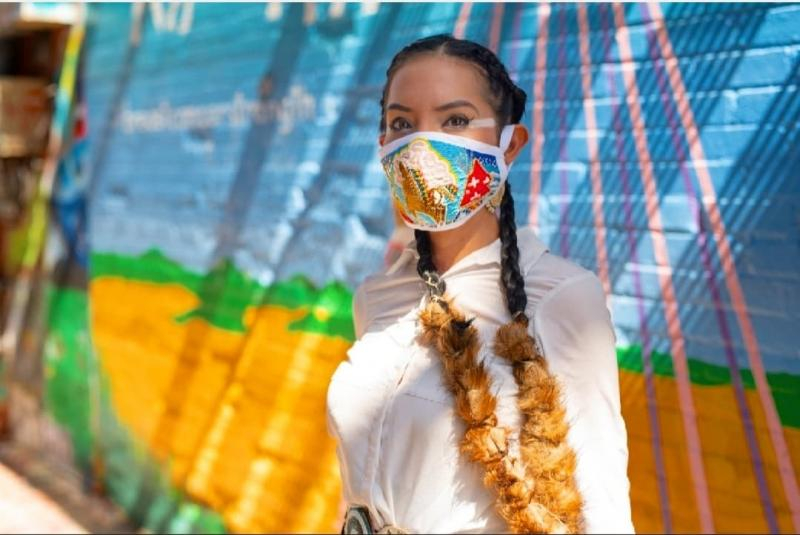 Standing in front of a mural she painted, Delaena Rae Uses Knife, Lakota Mnicoujou from the Cheyenne River Sioux Tribe, models the beaded mask she made to celebrate surviving COVID-19. Photographer credit (Cameko Photography)
Standing in front of a mural she painted, Delaena Rae Uses Knife, Lakota Mnicoujou from the Cheyenne River Sioux Tribe, models the beaded mask she made to celebrate surviving COVID-19. Photographer credit (Cameko Photography)
“I add my life experiences to my beadwork and my COVID-19 mask is my muse for survival. I put a war horse in the center and added Lakota Sioux tipis to symbolize the Lakota Star Nation,” said Uses Knife. “The horse is standing on lavender, which is symbolic of peace in the midst of crisis. I am a COVID-19 survivor and this is my story to tell.”
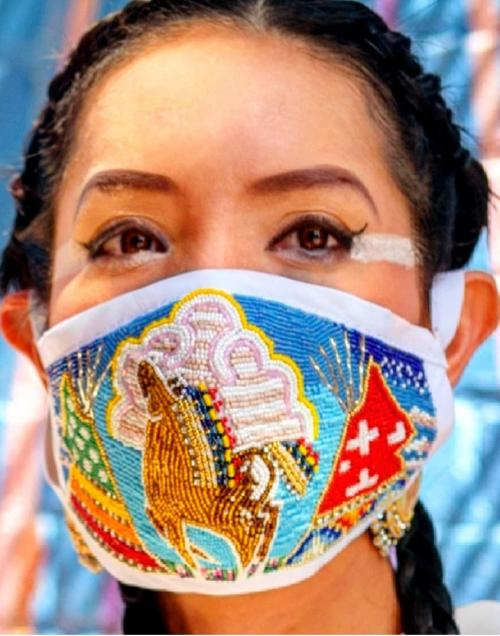 Delaena Rae Uses Knife, Lakota Mnicoujou from the Cheyenne River Sioux Tribe, models the beaded mask she made to celebrate surviving COVID-19. (Cameko Photography)Uses Knife created the felt-based mask as an art piece, but she said a filter could be added to make it protective.
Delaena Rae Uses Knife, Lakota Mnicoujou from the Cheyenne River Sioux Tribe, models the beaded mask she made to celebrate surviving COVID-19. (Cameko Photography)Uses Knife created the felt-based mask as an art piece, but she said a filter could be added to make it protective.
The mask gleams with cut glass beads in a kaleidoscope of Uses Knife’s favorite colors. The coppery warhorse with a multicolored mane of red, yellow, green and gold, stands proudly against white clouds lined in yellow and a sky of varying blue shades. Tipis formed with green, red, yellow and orange beads frame the shimmering scene.
Uses Knife had the well-being of her community on her mind well before she fell ill. In May, she used a celebration of her own talent to convey a message through her first hand-beaded mask.
After placing second in a logo contest for Rapid City coffee company Pure Bean Roasters, Uses Knife was scheduled to pose for a photograph and take part in a winners ceremony.
“I beaded a quick mask for my winning photo to show pandemic awareness,“ she said. “I wanted it to say something positive because I knew people would see me wearing it online.”
That “something positive” is the Lakota phrase “Zaniya Unpe!” which Uses Knife rendered in light blue beads. She said it means, “Everyone be healthy and safe!”
“I try to add my culture into my art and share knowledge with others. My father speaks Lakota fluently and helped me translate it,” Uses Knife said. “My first mask is a family-oriented design and I felt close to them while I was making it because I involved their ideas.”
Both of Uses Knife’s parents are accomplished artists, and she has been involved in Native arts all her life. 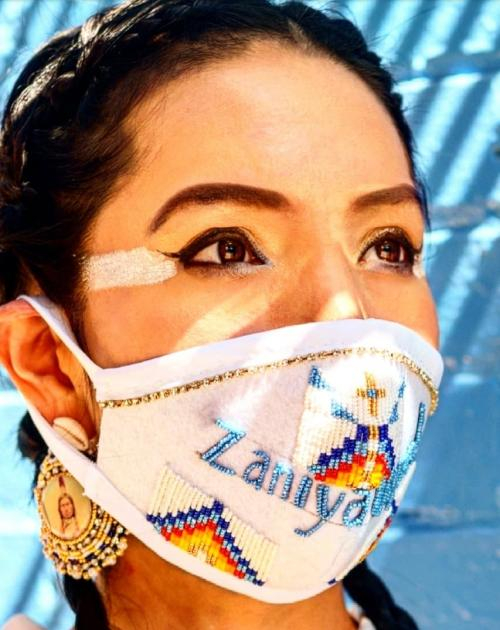 Delaena Rae Uses Knife, Lakota Mnicoujou from the Cheyenne River Sioux Tribe, decorated this beaded face mask with the Lakota words Zanya Unpe, meaning "Everyone be happy and safe!." (Cameko Photography)
Delaena Rae Uses Knife, Lakota Mnicoujou from the Cheyenne River Sioux Tribe, decorated this beaded face mask with the Lakota words Zanya Unpe, meaning "Everyone be happy and safe!." (Cameko Photography)
On the heavily symbolic mask, the yellow, orange and blue beaded pyramids flanking the Lakota words, represent the Black Hills, the sacred homeland of the Lakota. And the cross topping the highest pyramid stands for the Four Directions, “meaning, I'm praying for you in every direction,” Uses Knife said.
“I love incorporating the balance of heaven and earth showing we are connected and our prayers are heard by God.”
She posted an image of the mask on two popular Native American Facebook groups that popped up at the beginning of the pandemic: Social Distance Powwow and the Breathe., a community for Native mask makers.
When Uses Knife was sick, her family prayed hard for her recovery. Although they were separated, she still felt their support.
“I have to believe that faith and prayer got us through it because that’s all I had,” Uses Knife said. “It has to be more than a healthy immune system that allowed me to ‘breathe’ another day.”
Uses Knife said she most likely caught the virus from her boyfriend Adam Vollmer, who was sent home from work one day in early June because several of his co-workers had tested positive. Uses Knife said both she and Vollmer had worn masks and practiced social distancing to the best of their ability since March.
When Vollmer was diagnosed, he tried to distance himself from Uses Knife, even though they were both staying 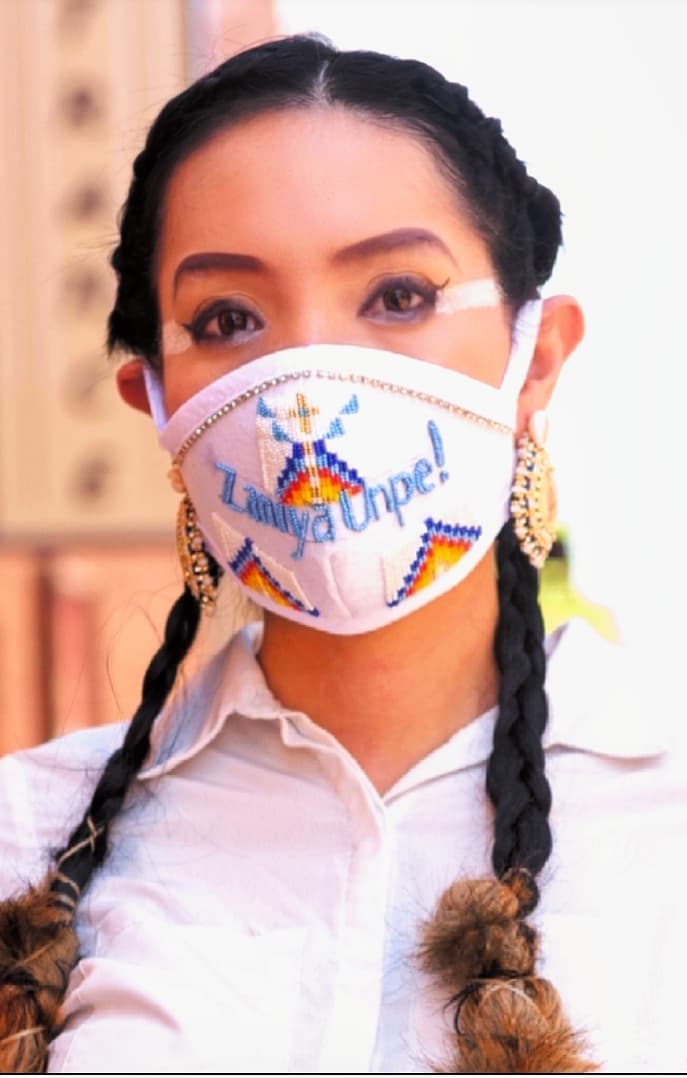 Delaena Rae Uses Knife, Lakota Mnicoujou from the Cheyenne River Sioux Tribe, decorated this beaded face mask with the Lakota words Zanya Unpe, meaning "Everyone be happy and safe!." (Cameko Photography)at his apartment. Once she was diagnosed, they were able to face the virus together.
Delaena Rae Uses Knife, Lakota Mnicoujou from the Cheyenne River Sioux Tribe, decorated this beaded face mask with the Lakota words Zanya Unpe, meaning "Everyone be happy and safe!." (Cameko Photography)at his apartment. Once she was diagnosed, they were able to face the virus together.
Uses Knife said she and Vollmer had mild symptoms for the most part, but there were some terrifying moments.
In addition to the three days she spent quarantining with a high fever, one day Vollmer drove her to the hospital when her pulse fell to an alarming rate.
“The doctors did a CT scan that found bacterial pneumonia [may be] in my lungs. They requested I stay the night so they could watch my symptoms and give me antibiotics and fluids to help me stay hydrated,” she said. “It was my first time staying in a hospital overnight and my family was not there.”
Uses Knife said she and Vollmer recovered after three weeks, but stayed home an extra week to be safe.
“Everyone prayed for us and checked on us throughout the whole recovery,” Uses Knife said.
Almost immediately after recovering, Uses Knife’s life took a wonderful turn when she was hired as a visual studio artist for a Rapid City entertainment company.
“I have much more to do in life and I am thankful,” she said. “I’ve been through a lot of disappointments, discouraging career moves and heartache in my life. I’m a successful artist because of my pain.”
More Stories Like This
From Dishwasher to Award-Winning Chef: Laguna Pueblo's Josh Aragon Serves Up Albuquerque's Best Green Chile StewRob Reiner's Final Work as Producer Appears to Address MMIP Crisis
Vision Maker Media Honors MacDonald Siblings With 2025 Frank Blythe Award
First Tribally Owned Gallery in Tulsa Debuts ‘Mvskokvlke: Road of Strength’
Zuni Youth Enrichment Project and Partners at Ho’n A:wan Productions Launch 8th Annual Delapna:we Project
Help us defend tribal sovereignty.
At Native News Online, our mission is rooted in telling the stories that strengthen sovereignty and uplift Indigenous voices — not just at year’s end, but every single day.
Because of your generosity last year, we were able to keep our reporters on the ground in tribal communities, at national gatherings and in the halls of Congress — covering the issues that matter most to Indian Country: sovereignty, culture, education, health and economic opportunity.
That support sustained us through a tough year in 2025. Now, as we look to the year ahead, we need your help right now to ensure warrior journalism remains strong — reporting that defends tribal sovereignty, amplifies Native truth, and holds power accountable.
 The stakes couldn't be higher. Your support keeps Native voices heard, Native stories told and Native sovereignty defended.
The stakes couldn't be higher. Your support keeps Native voices heard, Native stories told and Native sovereignty defended.
Stand with Warrior Journalism today.
Levi Rickert (Potawatomi), Editor & Publisher

